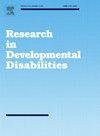Impact of fidget devices on anxiety and physiological responses in adults with ADHD
IF 2.9
2区 医学
Q1 EDUCATION, SPECIAL
引用次数: 0
Abstract
Background
Fidgeting devices are popular for managing ADHD, but their effectiveness remains unclear. This study investigated whether fidgeting modulates self-regulation in adults with ADHD during stress, exploring intrinsic versus extrinsic fidgeting with a fidget ball. We hypothesized that individuals with a fidget ball would demonstrate improved self-regulation under stress, reflected by higher heart rate variability (HRV) and lower anxiety levels.
Methods
Adults with ADHD were randomly assigned to a fidget ball (n = 49) or no fidget ball (n = 24) group. Physiological stress was measured via HRV and intrinsic fidgeting, that is, ankle and wrist movements, were measured via actigraphy. Physiological data were collected at baseline and during the Trier Social Stress Test (TSST). Self-rated anxiety was measured using the State Anxiety Inventory.
Results
Heart rate and fidgeting increased across TSST stages for both groups, with no significant differences in heart rate, HRV, or intrinsic fidgeting between groups. Notably, the fidget ball group had weaker correlations between fidgeting and HRV compared to the no fidget ball group. At baseline, the no fidget ball group showed a positive correlation between intrinsic fidgeting and HRV, suggesting an association between intrinsic fidgeting and self-regulation, however during stress the no fidget ball group showed a significant negative correlation between intrinsic fidgeting and HRV. The relationship between physiological measures and anxiety differed between groups and TSST stages.
Conclusions
These results provide preliminary evidence that the fidget ball may disrupt the expected association between intrinsic fidgeting and HRV, emphasizing the need for further studies to explore its impact on self-regulation.
求助全文
约1分钟内获得全文
求助全文
来源期刊

Research in Developmental Disabilities
Multiple-
CiteScore
5.50
自引率
6.50%
发文量
178
期刊介绍:
Research In Developmental Disabilities is aimed at publishing original research of an interdisciplinary nature that has a direct bearing on the remediation of problems associated with developmental disabilities. Manuscripts will be solicited throughout the world. Articles will be primarily empirical studies, although an occasional position paper or review will be accepted. The aim of the journal will be to publish articles on all aspects of research with the developmentally disabled, with any methodologically sound approach being acceptable.
 求助内容:
求助内容: 应助结果提醒方式:
应助结果提醒方式:


